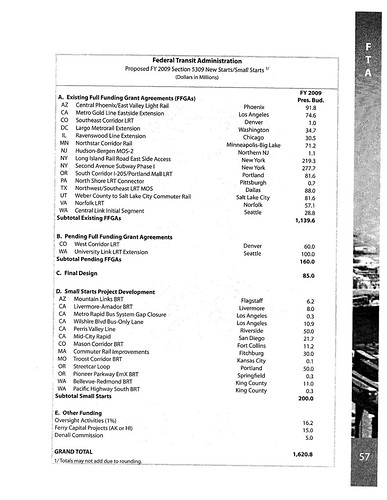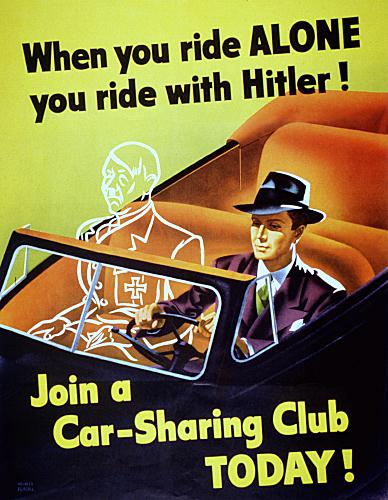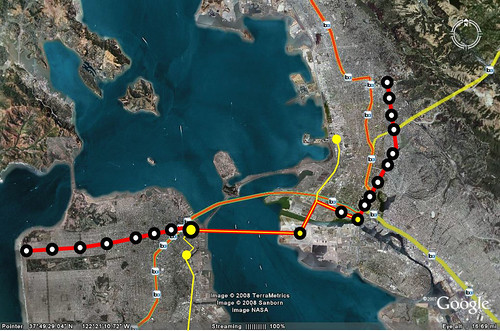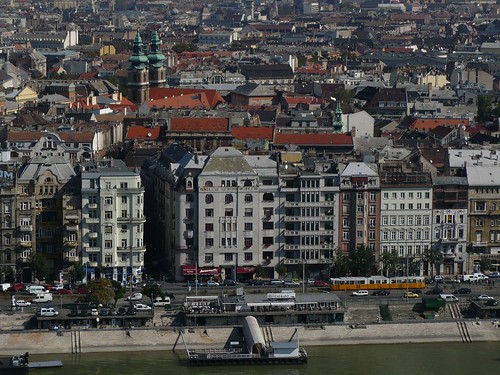Using regression analysis, he showed that in Minneapolis, aside from developing residential densities, transit share can be increased by building up commercial centers. In the regression, he showed that for every 1000 people per square mile that the residential density grew, the increase in transit's share to downtown increased 2.4% versus .6% increase when people went to suburban jobs. The same thing happened for increases in low income users. For every 1% increase in low income population per square mile, increases were noted. The chart that shows the results is below.

He also relates the concentration of regional jobs in major centers directly to how much transit people take. An example from the article is below.

There are a few caveats including the need for quality transit and parking regulations in these centers that encourage transit ridership. But just having a center of commerce isn't good enough. Places that have a lot of jobs like Pleasanton need to be better organized and less suburban office park.
Recently however, many people have been focused really heavily on residential densities, which are important, but I haven't seen many programs that create a regional job placement and growth strategy. This could be part of the key for increasing transit's use for work trips.
I have a feeling as well that pushing for dense commercial centers with mixes of retail and office then connecting them with high capacity transit will go a long way towards increasing transit's ability to cut congestion in the peak hours. It might also be a self-fulfilling prophecy of sorts, creating a cycle of more transit and more office development in the cores of a region.
I know that this is kind of a 'duh' post. But having numbers to quantify the effects of connecting residential areas to large employment centers is really important in moving forward with policies that promote transit ridership. Thanks Prof Barnes for this paper and for your conclusion:
Planners and policymakers hoping to manage urban traffic congestion through increased transit use are limited in the short term by the strong influence that existing land use exerts on mode choice. While this point has been widely acknowledged, most research and policy discussion on this topic has focused on increasing residential densities. However, the conclusion of this article is that the development and expansion of very large, high-density job centers is the best tool available for most cities to achieve substantial increases in transit use.
While there are many ways to improve transit use, achieving the substantial increases necessary to impact congestion levels will probably ultimately require greatly improved service frequency or higher costs of driving, such as parking charges. Higher parking charges will be politically infeasible in the absence of adequate transit service as an alternative; however, improved transit service is hard to justify in the absence of a sufficiently large market.
Creating a large market appears to reduce to two options: the well-known solution of increasing residential density and the less-considered option of focusing on the work end of the trip. While both of these tactics appear to be effective in principle as well as practice, it is, for a variety of reasons discussed in this article, very difficult to have impacts on residential density that are large enough to have regional significance.
The constraints that limit the use of residential density increases as a tool are not in force to nearly the same extent for commercial development. A gradual transition of a relatively small amount of office space from isolated or low-density settings into a few large dense centers could lead to sizable increases in regional transit use in a relatively short time.
The Twin Cities area illustrates the possibilities of this approach. There are two downtowns, but Minneapolis is much larger and is geographically in the center of the developed area. Downtown St. Paul is relatively small and close to the edge by comparison, yet still attracts a substantial transit share. This hints at the possibility that even suburban locations, if they are developed to a sufficient size and density, can become major transit attractors.
Increased densities at the work end of the trip, by making improved transit service frequency more viable, could also help to increase nonauto access to retail and other nonwork opportunities. While higher density residential development can also have an impact, the effect is much larger when the increased density occurs in or around high-density commercial areas, both because more trips will be made to these high-transit attractors and because these areas support relatively good transit service going out as well as coming in. Increased commercial densities, especially in the suburbs, may be the only tool available for inducing significant transit use from the vast suburban areas of most cities that are already developed at low densities, and which will probably stay that way forever.











